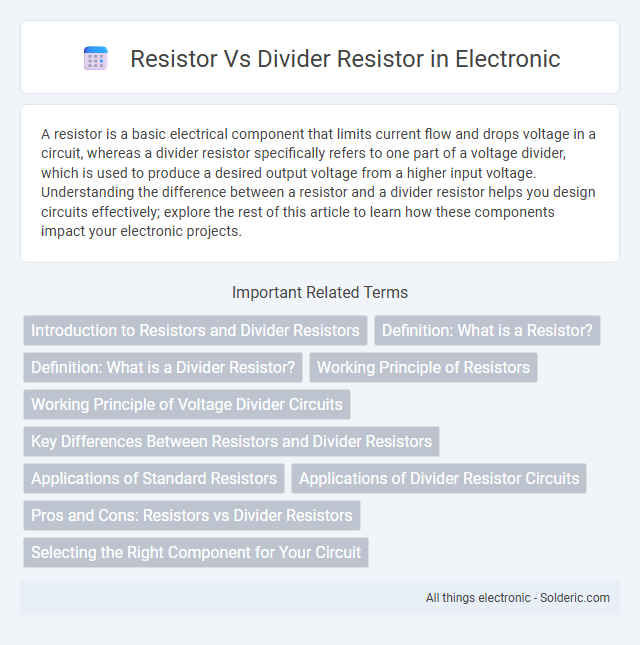A resistor is a basic electrical component that limits current flow and drops voltage in a circuit, whereas a divider resistor specifically refers to one part of a voltage divider, which is used to produce a desired output voltage from a higher input voltage. Understanding the difference between a resistor and a divider resistor helps you design circuits effectively; explore the rest of this article to learn how these components impact your electronic projects.
Comparison Table
| Feature | Resistor | Divider Resistor (Voltage Divider) |
|---|---|---|
| Definition | A passive electrical component that limits current flow. | Two or more resistors connected in series to produce a specific output voltage. |
| Primary Function | Control current and voltage in a circuit. | Divide input voltage into a lower output voltage. |
| Component Count | Single resistor. | Minimum two resistors. |
| Typical Application | Limiting current, setting bias points. | Voltage measurement, reference voltage, signal level shifting. |
| Output Voltage | Dependent on circuit conditions. | Predictable fraction of input voltage (Vout = Vin x R2/(R1 + R2)). |
| Power Dissipation | Varies with resistance and current. | Higher due to multiple resistors in series. |
| Complexity | Simple component. | Simple circuit but involves resistor selection and calculation. |
Introduction to Resistors and Divider Resistors
Resistors are fundamental electrical components that limit current flow and adjust voltage levels within circuits, typically characterized by resistance values measured in ohms. Divider resistors, arranged in series as voltage dividers, create specific output voltages proportional to the resistance ratios, enabling precise voltage scaling for sensors, signal conditioning, and reference signals. Understanding the differences between single resistors and resistor dividers is essential for designing circuits requiring accurate voltage control and current management.
Definition: What is a Resistor?
A resistor is a passive electrical component designed to limit or regulate the flow of electric current in a circuit by providing a specific amount of resistance measured in ohms (O). A divider resistor, often part of a resistor divider or voltage divider circuit, is used in combination with other resistors to produce a desired output voltage that is a fraction of the input voltage, enabling precise voltage regulation and signal conditioning. Resistors play a crucial role in controlling current, adjusting signal levels, and protecting components from excessive current in electronic devices and circuits.
Definition: What is a Divider Resistor?
A divider resistor, also known as a resistor used in a voltage divider circuit, is a component designed to split an input voltage into smaller, proportional output voltages. Unlike a single resistor that simply limits current, divider resistors work together in series to create precise voltage ratios based on their resistance values. This configuration is essential for adjusting signal levels, measuring voltages, and interfacing different parts of electronic circuits.
Working Principle of Resistors
Resistors limit the flow of electric current by providing specific resistance based on their material and geometry, converting electrical energy into heat. A divider resistor setup uses two or more resistors in series to proportionally split voltage according to their resistance values, enabling precise voltage control. Understanding the working principle of resistors helps you design efficient circuits for voltage regulation and current limitation.
Working Principle of Voltage Divider Circuits
Voltage divider circuits operate by splitting the input voltage into smaller output voltages using two or more resistors connected in series. The output voltage is determined by the ratio of the resistor values according to the formula Vout = Vin * (R2 / (R1 + R2)), where R1 and R2 are the resistors in the series. This principle allows precise control of voltage levels in electronic circuits, making voltage dividers essential for sensor interfacing and signal conditioning.
Key Differences Between Resistors and Divider Resistors
Resistors are passive electrical components that limit current flow and drop voltage within circuits, characterized by a fixed resistance value. Divider resistors, typically arranged in series to form a voltage divider, create a specific output voltage proportionate to the input voltage based on Ohm's law. Your choice between a single resistor and a resistor divider depends on whether you need simple current control or precise voltage scaling in your electronic design.
Applications of Standard Resistors
Standard resistors are widely used in electronic circuits for current limiting, voltage regulation, and signal conditioning due to their precise resistance values and reliability. Voltage divider resistors, a specific type of standard resistor arrangement, create reference voltages, scale signal levels, and bias active components by dividing input voltage proportionally. Applications span from sensor interfacing, analog-to-digital conversion, to power management in consumer electronics and industrial controls.
Applications of Divider Resistor Circuits
Divider resistor circuits are essential in electronic applications requiring voltage scaling, such as sensor signal conditioning, biasing transistors, and adjusting reference voltages in analog-to-digital converters. These circuits enable precise output voltage control by dividing input voltage according to resistor ratios, facilitating integration with microcontrollers and other low-voltage devices. Voltage divider networks also play a crucial role in level shifting and impedance matching across various signal processing systems.
Pros and Cons: Resistors vs Divider Resistors
Resistors provide simplicity and reliability, making them ideal for basic current limiting or voltage drop applications, but lack the precision control found in divider resistors. Divider resistors enable accurate voltage scaling and signal conditioning in circuits, though they introduce complexity and potential power loss due to the interplay between the two resistors. Your choice depends on whether you prioritize straightforward implementation or precise voltage adjustment for specific electronic applications.
Selecting the Right Component for Your Circuit
Selecting the right component for your circuit depends on whether you need a fixed resistance or a specific voltage output. A resistor provides a constant resistance to control current flow, while a divider resistor network creates a precise voltage division by splitting input voltage proportionally. Understanding your circuit's voltage and current requirements ensures your design operates efficiently and safely with the optimal resistor choice.
resistor vs divider resistor Infographic

 solderic.com
solderic.com